Are raccoons wreaking havoc in your neighborhood? Wondering who or what is brave enough to take on these mischievous little bandits? Look no further! In this wild and eye-opening blog post, we will unmask the top 12 raccoon predators that will make you think twice about underestimating these furry troublemakers. From cunning coyotes to unlikely domestic cats, these raccoon adversaries are ready to pounce. So, grab your popcorn and get ready to be amazed as we reveal the ultimate raccoon predator showdown!
Unmasking the Predators of Raccoons
Imagine a raccoon, with its distinctive masked face and nimble front paws, exploring its native North American habitat. You might see it as an adorable, harmless creature. But, in the grand scheme of the circle of life, raccoons are as much prey as they are predators. Their survival game is not exempt from the stealthy pursuits of hunters. This section offers a sneak peek into the world of raccoon predators, unleashing the answers to your curiosity about what actually eats raccoons.
| Common Raccoon Predators | Characteristics |
|---|---|
| Coyotes | Opportunistic hunters |
| Foxes | Agile predators |
| Bobcats | Stealthy stalkers |
| Wolves | The Canidae giants |
| Eagles | Aerial hunters |
| Owls | Silent predators |
| Snakes | Ambush predators |
From cunning coyotes that pounce on the opportunity to capture a raccoon to bobcats that use their stealth to silently stalk their prey, raccoons face a diverse range of predators. The list doesn’t stop there; agile foxes, the giant wolves of Canidae family, and the ever-watchful eagles also pose significant threats to these masked mammals. And in the quiet of the night, owls become silent killers, and snakes surprise raccoons with their ambush tactics.
As we delve deeper into the world of raccoon predators, we’ll uncover the survival strategies of raccoons and the predatory tactics of their hunters. By understanding the complex relationships between these creatures and their habitats, we can appreciate the intricate balance of nature.
1. Coyotes: The Crafty Opportunists of the Wild
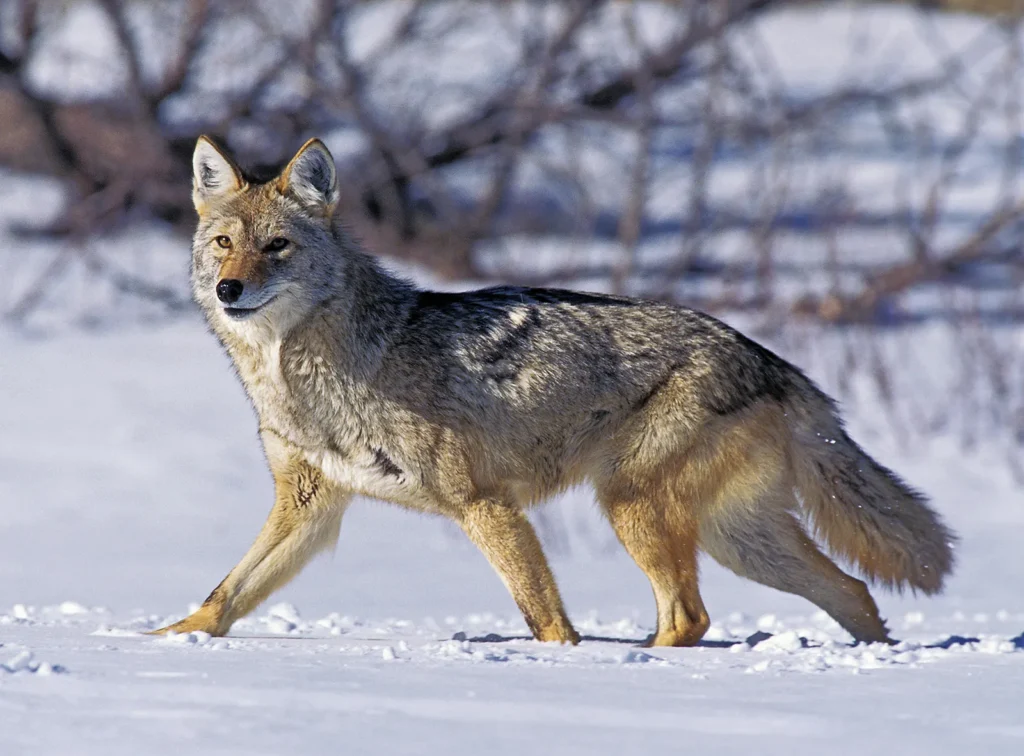
coyote
When the discussion turns towards the predators of raccoons, the cunning coyotes inevitably steal the limelight. Known for their resourcefulness and adaptability, coyotes hold the reputation of being one of the most common predators of raccoons. Their opportunistic nature makes them rather unpredictable as they adjust their feeding habits according to what’s readily available.
Read more: What are the Different Types of Raccoons? Unveiling the Fascinating World of Raccoon Species
Although raccoons do not form the crux of a coyote’s diet, it doesn’t mean they are entirely off the menu. In fact, a coyote would not hesitate to seize the opportunity if a raccoon ventures too close. This is a testament to the coyote’s versatile feeding habits and their knack for making the most of their surroundings.
“While coyotes primarily target white-tailed deer for sustenance, they also scavenge for plants, rodents, voles, rabbits, and even foxes.”
As the above quote illustrates, coyotes are not fussy eaters. They are well-equipped to handle a diverse range of food sources, which often includes raccoons. This adaptability makes them highly successful predators, able to thrive in various environments.
Coyotes are expert hunters with a keen sense of smell and incredible speed, which aids them in hunting down raccoons on the ground. But their tactics do not end there. These clever creatures may also resort to ambush strategies, lurking silently in trees or bushes, ready to pounce when an unsuspecting raccoon comes into range.
Read more: Are Raccoons Rodents? Unveiling the Truth Behind Their Classification
Given their wide-ranging diet and strategic hunting techniques, it’s no surprise that coyotes play a significant role in the ecosystem, controlling the population of many small mammals, including raccoons. In the grand tapestry of nature, every creature, from the silent owls and sly snakes to the crafty coyotes, has its part to play, and understanding these relationships help us appreciate the intricate balance of life in the wild.
2. Foxes: Agile Predators
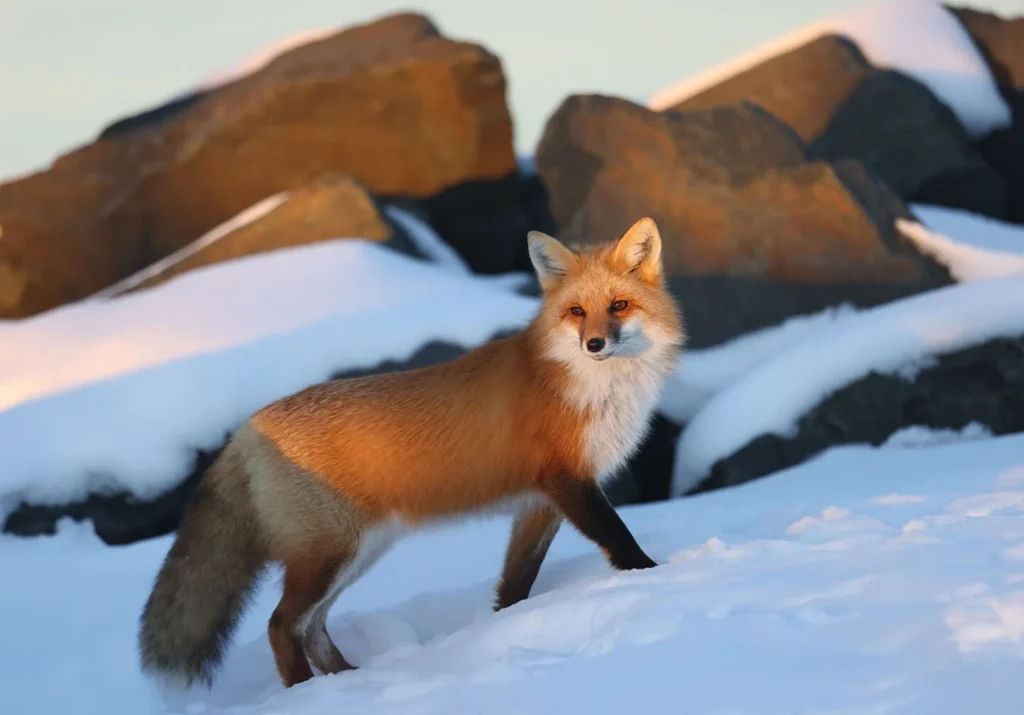
fox
In the dense tapestry of nature, raccoons face a multitude of threats, and one of their stealthiest opponents is the fox. Known for their speed and agility, foxes transform the art of hunting into a breathtaking ballet of precision and cunning.
Unlike their larger counterparts, the coyotes, foxes typically lead solitary lives, each one a master of its own terrain. This individualistic lifestyle influences their hunting habits, creating a unique dynamic in their relationship with raccoons.
Foxes are particularly adept at identifying vulnerabilities in their prey. They are likely to target an elderly or sick raccoon, sensing the weakened state of their potential prey from afar. Young raccoons, also known as kits, are also at risk due to their lack of experience and smaller size.
While wolves and coyotes may hunt in packs, a fox relies on its own guile and swiftness, making each encounter with a raccoon a tense game of survival.
Raccoons and foxes often share overlapping territories, leading to inevitable confrontations. Both are primarily nocturnal creatures, which means their paths are likely to cross under the veil of darkness. However, foxes are not strictly bound to the night. They are known to venture out during the day, hunting or moving from one hiding place to another.
The life of a raccoon in a fox-populated area is a constant test of alertness and adaptability. Every rustle in the underbrush, every shadow could signal the presence of a fox. For the raccoons, survival means staying one step ahead of these agile predators.
Thus, the fox plays a crucial role in the ecosystem by keeping the raccoon population in check. Their hunting strategies and adaptability contribute significantly to the intricate balance of wildlife, demonstrating the interconnectedness of all creatures in the circle of life.
3. Bobcats: Stealthy Stalkers
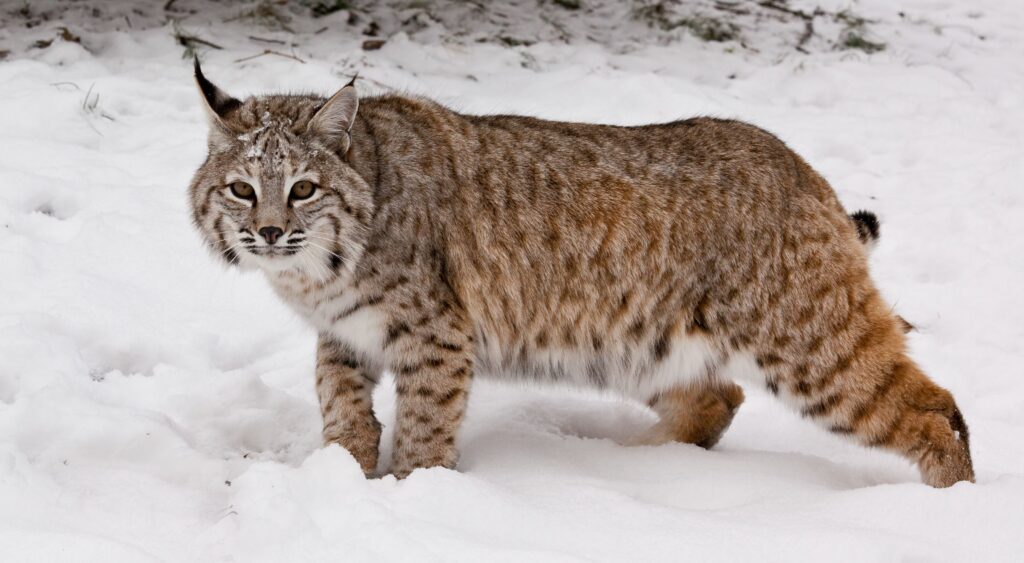
bobcat
Stepping into the spotlight as another skilled adversary of raccoons are the bobcats. These hunters of the wild display an uncanny degree of patience and stealth in their hunting expeditions, outdoing most predators in their class.
Bobcats, with their sharp claws and keen eyes, are perfectly designed for the hunt. They thrive in the quiet, where they can observe without being observed.
When it comes to raccoons, bobcats employ a fascinating hunting technique. They stalk their prey from afar, their eyes never straying from the target. Every movement of the raccoon is closely monitored, each scurry and rustle in the underbrush noted.
Unlike the coyotes and foxes that rely on their agility and speed, a bobcat’s hunting style is all about patience and precision. They wait, still as a statue, watching as the raccoon goes about its business, oblivious to the danger lurking nearby.
Once the moment is right, the bobcat springs into action. They may ambush a foraging raccoon, or even attempt to catch one off guard while it’s navigating between trees. The bobcat’s attack is swift and deadly. With a quick bite to the neck or head, using their razor-sharp teeth and claws, they can bring down a raccoon in an instant.
Read more: Are You Prepared? Here’s What You Need To Do if a Raccoon Bites You
After the hunt, the bobcat typically drags its prize to a secluded spot. Here, away from the prying eyes of other predators, the bobcat can feast on its well-earned meal.
The bobcat’s hunting style illustrates the complex dance of the wild – the balance between predator and prey, the fine line between life and death. It’s a testament to the bobcat’s skills as a hunter and the role they play in controlling the raccoon population.
So, the next time you see a bobcat, take a moment to appreciate these stealthy stalkers and their vital role in the ecosystem.
4. Wolves: The Canidae Giants
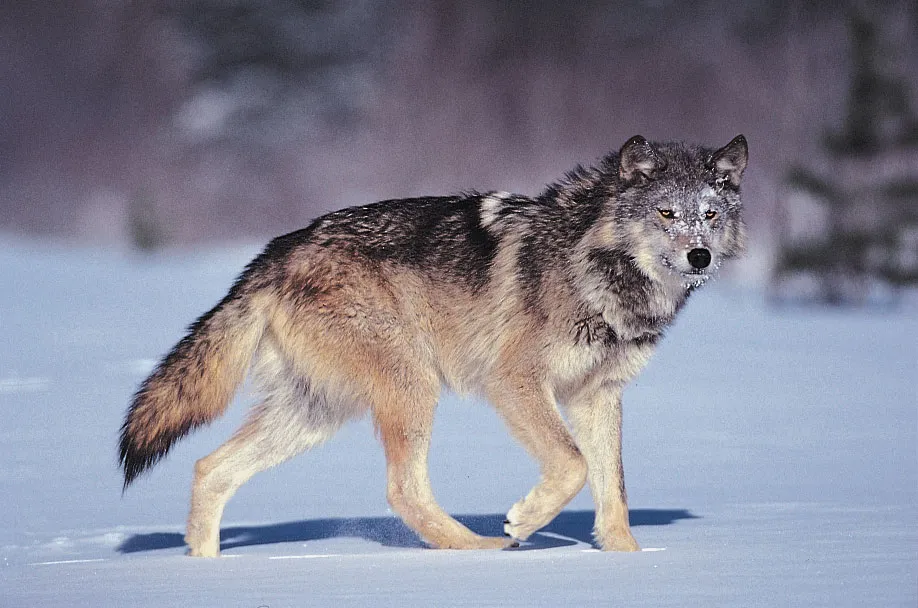
wolf
Imagine standing face to face with a creature whose shoulders are as high as your waist, its piercing yellow eyes staring into your soul, and a set of sharp, gleaming teeth bared in a low growl. This imposing figure is none other than the wolf, the largest member of the Canidae family. As one of nature’s most formidable predators, wolves are renowned for their ability to take down large prey such as elk and moose. They represent the brute force of the animal kingdom and play a pivotal role in maintaining the balance of ecosystems.
Now, you might be wondering, where do raccoons fit into the picture? The answer is interesting. Wolves and raccoons often share habitats, and while raccoons are not the preferred meal of these Canidae giants, they are not off the menu. Raccoons, despite their size, are a potential food source for wolves, particularly when the latter are hunting alone.
When a hungry wolf encounters a raccoon, it’s a battle of wit versus might.
Picture this scene: A lone wolf, separated from its pack, roams the forest under the moon’s soft glow. Its keen eyes spot a raccoon rummaging through the underbrush. The wolf, driven by hunger, decides to seize the opportunity. With a swift sprint and a powerful leap, the wolf manages to secure its small, but satisfying meal. This is a rare occurrence, for wolf packs typically hunt larger prey, leaving raccoons to the foxes and bobcats.
However, life in the wild is unpredictable. When food is scarce, and survival hangs by a thread, the wolf’s survival instincts kick in, and it adjusts its preferences. In these situations, a raccoon becomes fair game.
Read also: Deer Hooves Unveiled: The Ultimate Guide to Understanding Deer Feet
The dynamic interplay between wolves and raccoons, though not as frequent as with other predators, is a testament to the intricate web of life in the animal kingdom. It’s a constant reminder of the delicate balance that exists in nature and the key role that predators like wolves play in maintaining it.
5. Mountain Lions: Night Predators
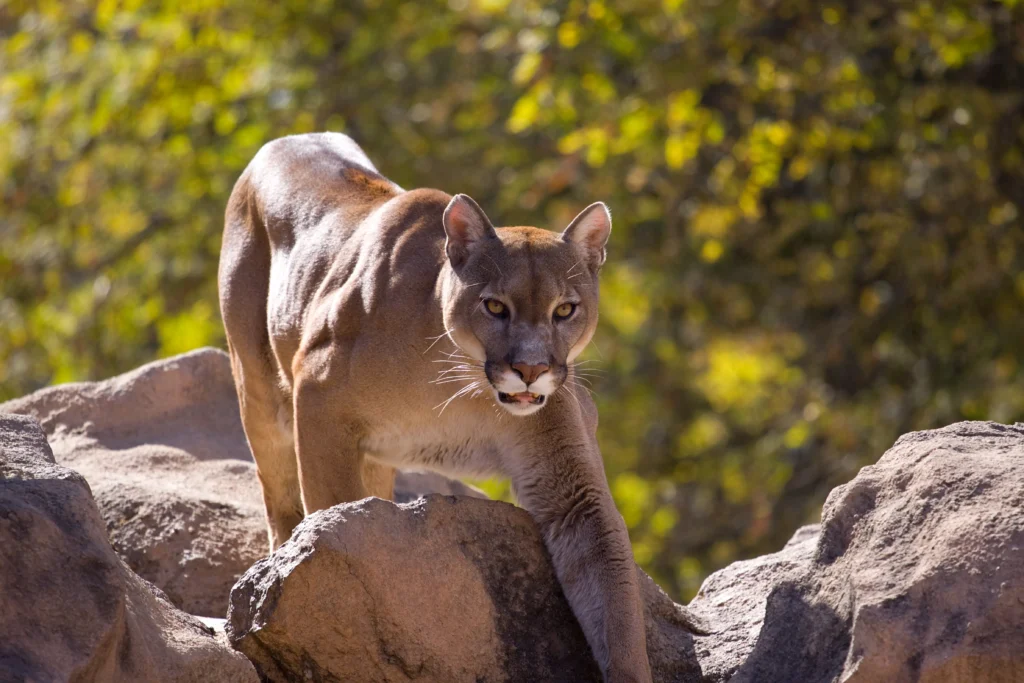
mountain lion
When the sun sets and the moon takes its place, a different kind of predator awakens and begins its prowl. Silent yet deadly, the Mountain Lion is the master of the night and the embodiment of predatory stealth. Even though they are famed for their hunting prowess with larger victims like deer, these solitary hunters do not limit their menu. They are opportunistic predators, and raccoons, despite not being their primary prey, do find their way onto the mountain lion’s menu.
With eyes that pierce through the darkness, an acute sense of smell, and hearing that picks up the faintest rustle, Mountain Lions are perfectly equipped for their nocturnal hunts. Like the Bobcats we previously discussed, Mountain Lions also adopt a stalking strategy when hunting raccoons. They observe their prey from a distance, matching every move with calculated patience.
Picture this: A raccoon, unaware of the impending danger, is scavenging for food in the dead of the night. In the shadows, the Mountain Lion watches, its eyes locked on the raccoon. It patiently waits, perfectly blending in with the darkness. And then, in a swift and ruthless moment, the Mountain Lion pounces, showcasing its raw power and precision.
Mountain Lions, like the other predators we’ve discussed, play a crucial role in maintaining the balance of nature. By preying on raccoons, they help control the raccoon population, thus preventing an overpopulation that could lead to serious ecological issues.
Join us as we dive deeper into the world of raccoon predators, shifting our gaze from the ground to the sky in our next section, “Eagles: Aerial Hunters”.
6. Eagles: Masters of the Sky and Aerial Hunters
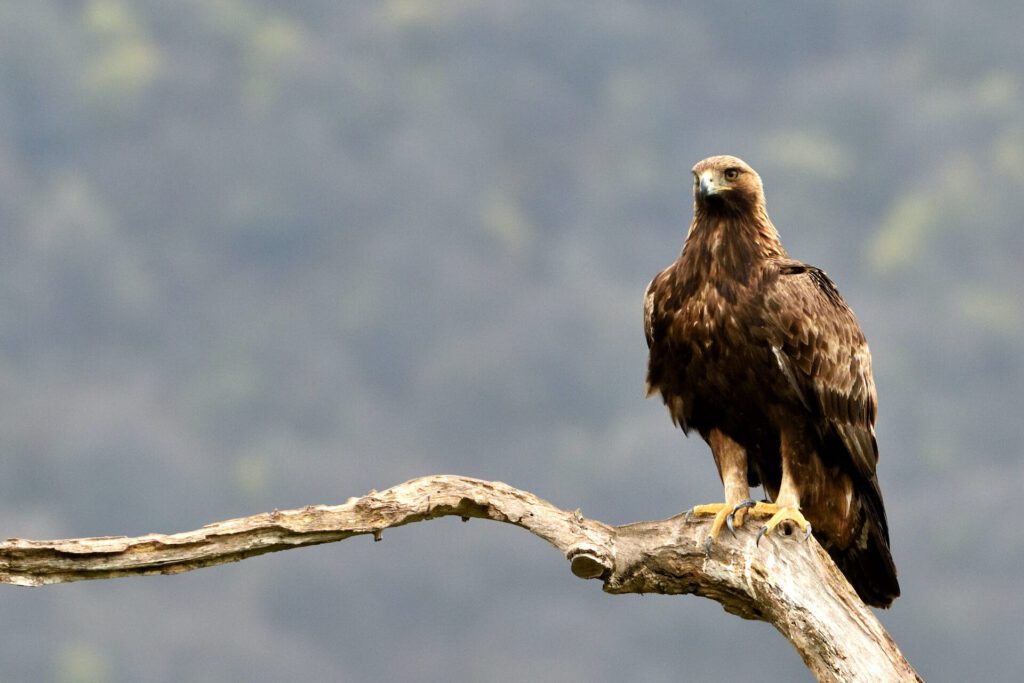
golden eagle
As we venture further into the surprising world of raccoon predation, we encounter a powerful predator that rules the skies: the eagle. Like the mountain lions, eagles are exceptional hunters, but they conduct their deadly ballet in the vast expanse of the sky rather than the dense underbrush.
Two types of eagles, in particular, have been observed hunting raccoons: the majestic Bald Eagle and the formidable Golden Eagle. Both species are paragons of avian power and agility, equipped with razor-sharp talons and beaks that can pierce and grip with deadly precision.
“The eagle’s eyesight is up to eight times more powerful than that of a human, allowing it to spot prey from miles away.”
Just imagine the scene: a raccoon scurrying through the forest, oblivious to the danger soaring high above. Suddenly, a powerful shadow swoops down. Talons outstretched, the eagle strikes with lightning speed and ferocity. The raccoon doesn’t stand a chance.
While eagles primarily hunt fish, they are not opposed to diversifying their diet, especially when the opportunity presents itself. Raccoons, though not a common item on the eagle’s menu, are fair game. Eagles are highly adaptable hunters, able to chase down raccoons on the ground, or ambush them in trees or bushes. They can swoop down from great heights, using their superior vision to spot and track their prey.
Read about: What Eats Lions? Discover the Top 5 Natural Enemies That Pose a Threat to the King of the Jungle
The act of eagles preying on raccoons is both a testament to their incredible hunting prowess and a vivid demonstration of nature’s food chain at work. Eagles, like the other predators we’ve discussed, play a crucial role in regulating the raccoon population and maintaining the delicate balance of their shared ecosystems.
So, when you next find yourself asking, “Do eagles eat raccoons?” the answer is a resounding yes. They may not do it often, but when they do, it’s a sight to behold.
7. Owls: Silent Predators
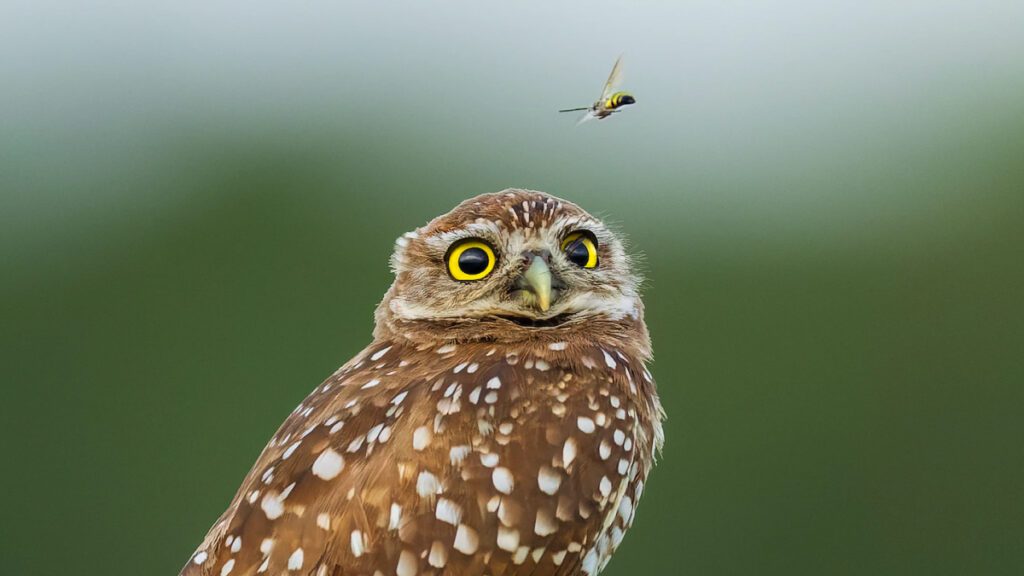
owl
Imagine a predator swooping down from the shadows, as silent as a whisper, its eyes glowing eerily in the dark. This is not a scene from a horror movie, but a typical hunting scenario for one of the raccoon’s most formidable adversaries: the Great Horned Owl.
Often overlooked in the competitive world of carnivorous predators, these magnificent creatures are North America’s largest owls. As twilight descends, these nocturnal hunters come alive, using their extraordinary hunting skills to catch elusive prey, including raccoons.
Great Horned Owls are skilled hunters that can prey on raccoons using their talons. Their silent flight and nocturnal habits make them formidable predators.
Equipped with razor-sharp talons and strong beaks, Great horned owls are capable of taking down prey larger than themselves – a testament to their power and agility. They have been known to attack skunks, opossums, and even cats. Yet, it’s their mastery of stealth that truly sets them apart. Gliding on silent wings, they swoop down, unseen and unheard, to seize the unsuspecting raccoon.
While it’s not a common occurrence for owls to prey on raccoons, the Great horned owl is an exception. Their hunting prowess combined with their adaptability makes them a silent yet deadly predator in the raccoon’s world.
Also check out: Do Lions and Tigers Share the Same Territory in the Wild?
These owls are not just hunters, but also a vital part of the ecosystem, controlling the population of small mammals and maintaining ecological balance. This includes a wide variety of prey, from rats and mice to rabbits and, of course, raccoons.
Remember, the next time you hear the soft hoot of an owl at night, it might just be a Great Horned Owl, a master predator silently patrolling the night sky, ready to swoop down on its unsuspecting prey.
8. Snakes: The Unseen Ambush Predators
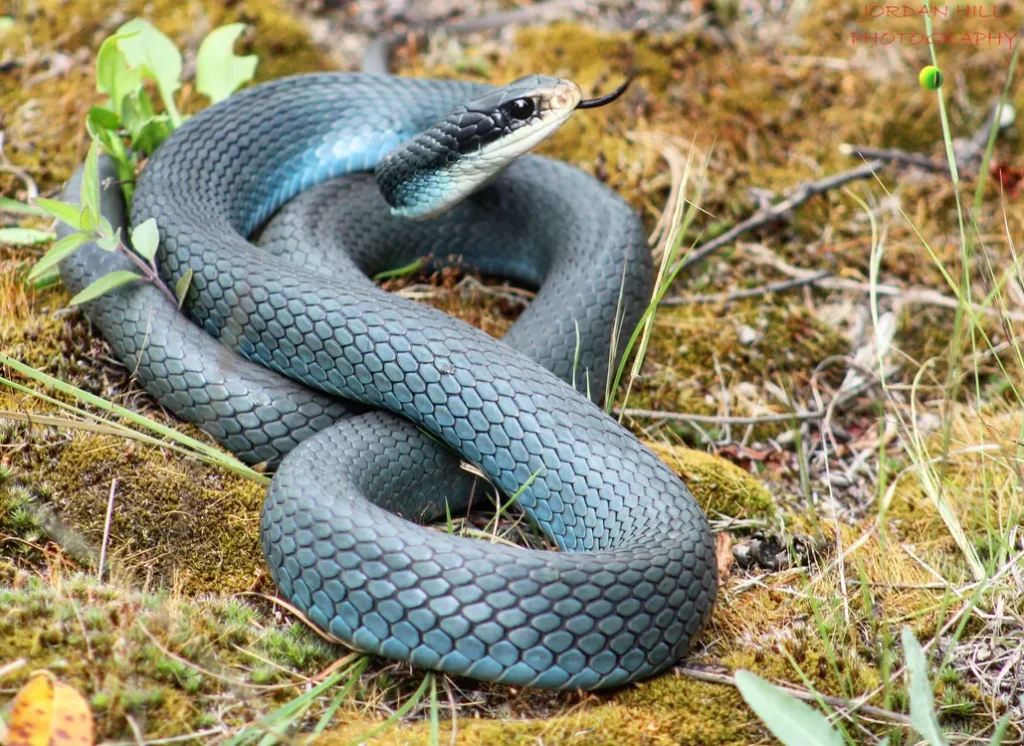
snake
Just as night descends and raccoons start to forage, another predator emerges from the shadows. Silent and stealthy, these creatures are often overlooked in the grand scheme of the ecosystem. We’re talking about snakes – the unseen ambush predators of the raccoon world.
Snakes, particularly larger species such as pythons, anacondas, and certain rattlesnakes, are quite capable of swallowing raccoons whole. While this might seem a daunting task given the size of a raccoon, it’s actually quite normal for these serpentine hunters. Their jawbones have incredible elasticity, allowing them to consume prey significantly larger than their head.
“Snakes are opportunistic feeders, and a raccoon makes for a substantial meal.”
Interestingly, raccoons do not form a regular part of the snake’s diet. However, when the opportunity arises, snakes are not ones to turn down a hefty meal. The ambush strategy employed by snakes is one of stealth and patience.
They lie in wait, camouflaged within their surroundings, sensing vibrations and movements that signal the approach of potential prey. Once within striking distance, they strike swiftly, subduing their prey with their strong jaws and constricting body. The raccoon, often taken by surprise, is rendered defenseless against this sudden onslaught.
While the thought of such a predator may be unsettling, it’s important to remember that snakes play an essential role in maintaining the balance in our ecosystems. By controlling the raccoon population, they indirectly influence the populations of other animals and plants, contributing to a dynamic, healthy environment.
Check out: Are You Familiar with These 12 Fascinating Iguanas? Get to Know Them with Stunning Pictures!
In the grand scheme of the forest food web, snakes are a compelling testament to the strength and adaptability of nature’s diverse hunters. But remember, this is only one chapter in the ongoing saga of the predators that hunt raccoons. Stay tuned as we explore more.
9. Alligators: The Apex Predators
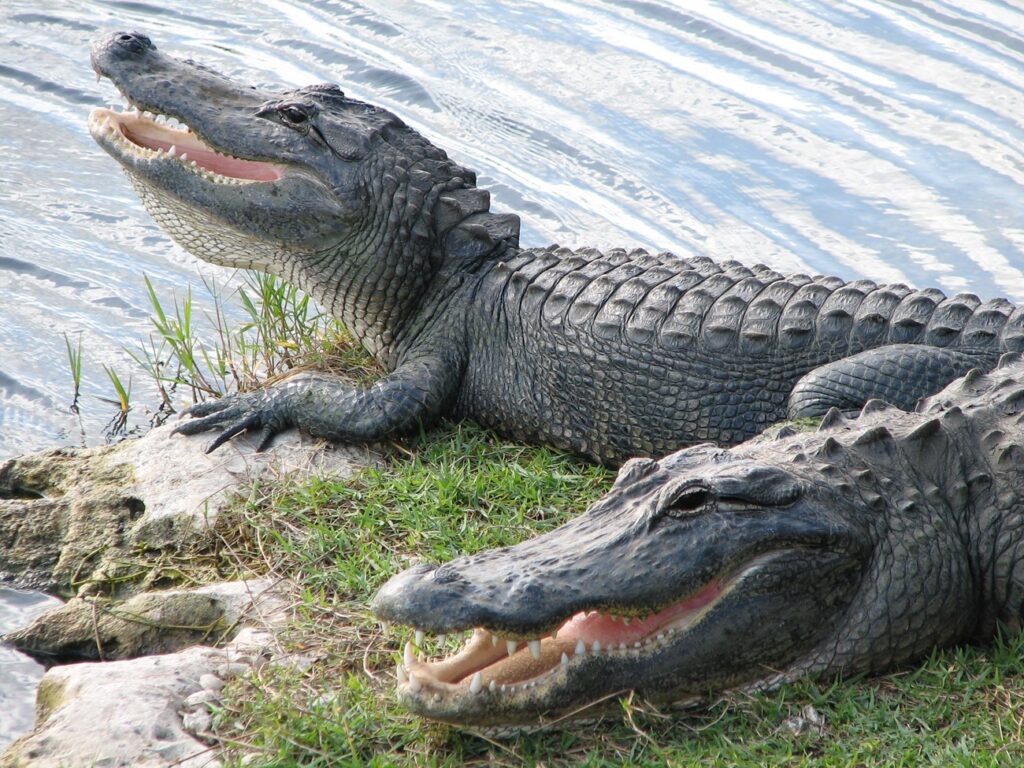
alligators
Having navigated through the world of terrestrial and aerial predators of raccoons, such as the stealthy owls and the swift snakes, we now venture into the wetlands – the chilling domain of the formidable Alligators.
As apex predators, alligators are a testament to the unyielding power of nature. Sitting atop the food chain, these reptilian behemoths are a force to be reckoned with, for even the most daring raccoons.
Just as the owl uses its talons and the snake its constricting coils, the alligator employs its own deadly weaponry. Imagine a pair of powerful jaws, lined with sharp, serrated teeth capable of delivering a lethal bite. This is the last sight many raccoons behold, for these jaws spell the end of their foraging escapades.
But it’s not just the alligator’s physical prowess that makes it a formidable predator. It’s the alligator’s uncanny ability to blend into its surroundings, lurking unseen in the murky depths of wetlands, rivers, or lakes. Here, the alligator is the master of the ambush, lying in wait for its unsuspecting prey.
Read more: Do Raccoons Really Kill and Eat Cats? Unveiling the Truth and Keeping Your Feline Friend Safe
A raccoon, lured by the possibility of a meal near the water’s edge, becomes the meal itself. In a flash, the silent predator strikes, snatching the raccoon in its powerful jaws. The raccoon, so adept at evading land predators, meets its match in the cunning and power of the alligator.
Thus, alligators play a significant role in controlling raccoon populations, particularly in regions where these aquatic predators abound. The gritty battle between the alligator and the raccoon is yet another reminder of the harsh yet intricate web of survival woven in the wild.
10. Domestic Cats: The Unlikely Predators
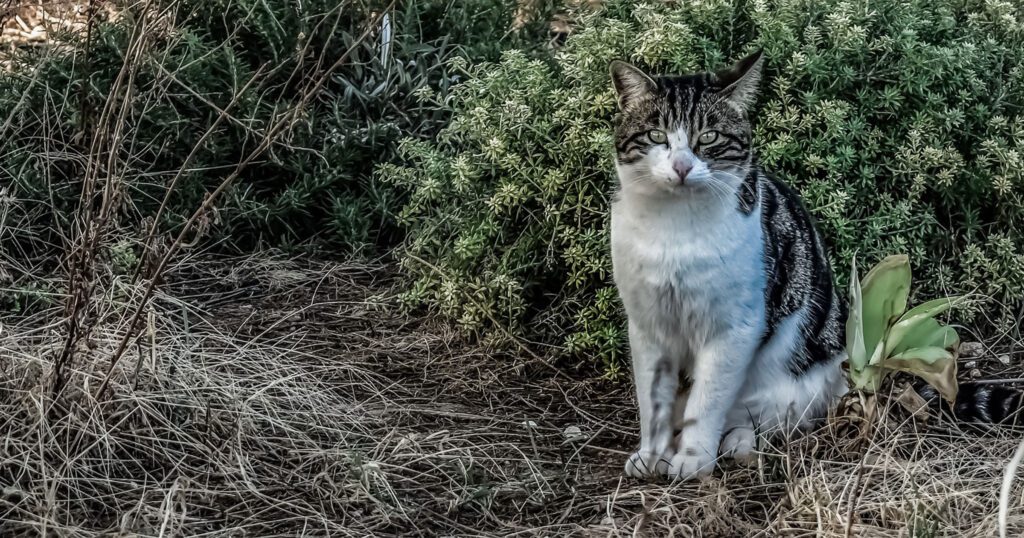
domestic cat
In the vast and ruthless world of nature, some predators of raccoons may come as a surprise. Among the unlikely candidates, we find our very own domestic cats. Though they may seem docile and harmless within the confines of our homes, these seemingly innocent creatures possess a lethal hunting prowess that may pose a threat to raccoons.
Domestic cats, having made the leap from the wilderness of Africa to the hearths of human homes, have not entirely shed their predatory instincts. They are particularly adept at hunting small mammals and birds, a trait that has earned them a formidable reputation, especially when they venture outdoors. In the case of raccoons, it’s the young or sick that fall prey to these feline predators.
While raccoons are larger than the typical prey of domestic cats, there have been recorded instances of cats attacking and killing young or sick raccoons. The predator-prey interaction is not restricted merely to the wild but extends to our backyards.
However, it’s important to note that domestic cats are not native predators of North America, the natural habitat of raccoons. Their influence on the local wildlife, therefore, is a result of human intervention. Their presence and predation can have a significant impact on wildlife populations. Outdoor cats, in particular, pose a substantial threat.
Despite their cute and cuddly appearance, domestic cats are skilled hunters, demonstrating that the line between pets and predators can sometimes blur. Thus, amidst the pantheon of raccoon predators, domestic cats carve out their own niche as an unlikely but potent danger.
11. Dogs: Potential Predators on Paws
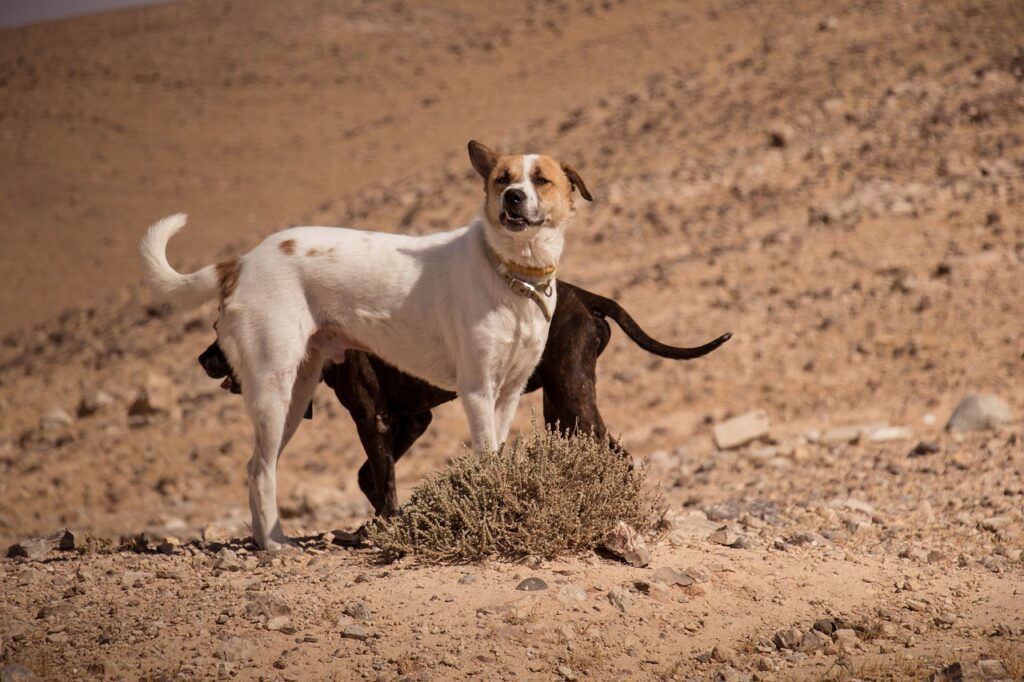
dogs
In the complex and often surprising world of predators, our domesticated companions, dogs, have a chapter of their own. While their deep-set loyalty and playful disposition can make it hard to imagine, dogs can, and sometimes do, prey on raccoons.
Picture this: a quiet suburban night is disrupted by the rustle of leaves. A raccoon, in pursuit of an easy meal, has found its way into a backyard. Suddenly, the silence is broken by a dog’s bark. This isn’t a scene from a thriller movie. It’s a scenario that can unfold in neighborhoods where dogs and raccoons co-exist.
Now, let’s delve into the heart of the matter. Particularly, hunting breeds like the coonhounds, which are specifically bred to track and hunt raccoons, are noteworthy. These dogs possess an acute sense of smell, rivaling that of their wild relatives, the wolves. Their name, “coonhound,” is a testament to their raccoon hunting prowess. The coonhound’s deep, baying voice rings out in the night, a signal to their human companion that a raccoon has been treed.
However, it’s not only these specialized breeds that can pose a threat to raccoons. Uncontrolled dogs, regardless of breed, can also chase and attack raccoons, driven by their inherent predatory instincts. The outcome of such encounters can result in harm to both the dog and the raccoon. It’s a reminder that even in urban environments, the age-old dance between predator and prey continues.
This interaction, though, is a double-edged sword. While it illustrates our dogs’ primal instincts, it also highlights the importance of responsible pet ownership. Ensuring dogs are kept under control, especially at night when raccoons are most active, is crucial in maintaining harmony between nature and our domesticated companions.
So, the next time you hear your pup barking at the night, it might very well be signaling its primal role in the grand tapestry of nature, reminding us of their lineage that traces back to the wild.
12. Humans: The Unnatural Predators
Among the myriad threats that raccoons must contend with, humans present an entirely different kind of danger. We are not their natural predators, yet our actions, both deliberate and unintentional, can have significant and often detrimental impacts on raccoon populations.
In the wild, raccoons face threats from a variety of natural predators, such as bobcats, foxes, and eagles. However, when we step into the picture, the dynamics change drastically. Unlike these natural predators, our motives for hunting raccoons are far removed from the usual cycle of life and survival. Our reasons range from the utilitarian to the downright destructive.
Humans have been known to hunt raccoons for their fur, a practice that, while not as prevalent as it once was, still persists in certain areas. The raccoon’s thick, warm fur has been a sought-after commodity in the fur trade, leading to countless raccoons being trapped and hunted. This practice could have disastrous effects on local populations, disrupting their natural balance and pushing them into vulnerable status.
“The hunt for raccoon fur is not a matter of survival, as with other predators, but a commercial enterprise that can have a devastating impact on raccoon populations.”
In addition to hunting, humans often perceive raccoons as pests due to their knack for getting into trash cans and making a mess. This perception has led to many instances of raccoons being killed as a form of pest control, a practice that, while seen as necessary by some, is often carried out without consideration for the animal’s right to life and habitat.
However, not all threats from humans are intentional. The relentless march of urbanization often leads to habitat destruction, with forests and open spaces being converted into roads, buildings, and other human-centric infrastructures. This loss of their natural habitat can be devastating for raccoons, forcing them into smaller and more fragmented areas that may not provide enough resources for their survival.
Even our highways pose a danger to these agile creatures. Raccoons, being nocturnal, are often active during the hours when traffic is highest. This unfortunate timing, combined with their relatively small size, makes them susceptible to vehicle collisions, a leading cause of raccoon deaths in urban areas.
Understanding our role as unnatural predators of raccoons is crucial in working towards a more harmonious coexistence with these fascinating creatures.
Conclusion
In the grand theater of nature, the raccoon plays a multifaceted role. Being both predator and prey, their existence is a testament to the intricate web of life that spans across diverse habitats. From the lush green forests to the bustling urban landscapes, each environment presents its own unique set of challenges for the raccoon, their survival ultimately shaped by the predators they face.
Imagine a raccoon, its masked face illuminated by the moonlight, cautiously navigating the forest floor. In the rustling leaves and shadowy undergrowth, threats lurk. Predators like coyotes, bobcats, and foxes are common in many habitats, their keen senses and predatory instincts making them formidable foes. The raccoon must rely on its agility and cunning to evade these predators and live to see another day.
Yet, not all dangers are confined to the forest floor. The sky above can suddenly become a hunting ground as aerial hunters like eagles and owls swoop down, their silent wings casting ominous shadows. The raccoon, ever-vigilant, has to be mindful of threats from above as well.
Conversely, some predators, such as bears and alligators, are region-specific threats. These apex predators only come into the picture in particular habitats, their presence adding another layer of complexity to the raccoon’s survival equation.
But the most ubiquitous and dangerous predator that the raccoon encounters is not one with sharp teeth or claws, but one that constructs buildings and highways. Yes, we are referring to humans, the unnatural predators. Often, raccoons fall victim to human activities, from fur hunting and pest control to habitat destruction and road accidents.
The raccoon’s plight serves as a stark reminder of our role in disrupting the natural balance. As we continue to encroach upon their habitats, we must understand our responsibility to ensure their survival. After all, each creature, including raccoons, plays a vital part in maintaining the delicate balance of our ecosystems.
Raccoons have to worry about predators such as bobcats, foxes, wolves, coyotes, eagles, snakes, large birds of prey, carnivorous mammals, alligators, domestic cats, and dogs.
The most common predators of raccoons are coyotes, foxes, bobcats, and owls.
Wolves are known to prey on raccoons, although it is not a common occurrence. They primarily target larger prey such as elk and moose.
Yes, humans can be a threat to raccoons. They may hunt raccoons for their fur or as a form of pest control. Additionally, habitat destruction and vehicle collisions can inadvertently harm or kill raccoons.

